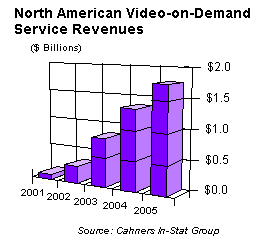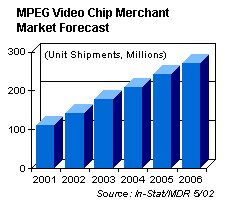| Movies
on Demand to be Coming Attraction for Broadband
SCOTTSDALE, Ariz., June 5, 2002
- As deployments of cable modems and Digital Subscriber Line (DSL)
services continue to increase throughout the world, Video-on-Demand (VOD)
services over Internet Protocol (IP) networks will grow to a total of
more than 17 million users, generating over $1.9 billion (US) in
subscription and pay-per-view revenue during 2006, according to
In-Stat/MDR. The high-tech market research firm reports, that as
consumer-oriented VOD services over IP become more pervasive, revenue
generated by family-oriented VOD services will eventually surpass
those of adult content sites, which currently dominate the VOD-over-IP
market. “Consumers who have broadband Internet connections represent a
strong growth market for VOD services,” says Gerry Kaufhold, a
Principal Analyst with In-Stat/MDR. “Adult content Internet VOD
services are way ahead of cable TV VOD deployments in terms of total
subscribers and revenues. However, four new family-oriented VOD-over-IP
service efforts are underway: CinemaNow, Intertainer, MovieLink, and
Movies.com.” CinemaNow has deployments in North America, Taiwan, and
Singapore, with more to come. Intertainer is rolling out their service
in 35 major U.S. cities that have strong broadband deployments in
place and the other two services will launch later this year.
Middleware "Magic Bullet" to Enable the Digital Media Continuum SCOTTSDALE, Ariz., May 1, 2002
- As broadband applications begin to migrate up and down the bandwidth
continuum, the dividing lines between television stations, Cable TV
headends and corporate streaming media networks will blur, according
to new research from In-Stat/MDR. The high-tech market research firm
reports that, as this occurs, new players with innovative products may
quickly out-distance long-established companies who fail to see the
walls of their vertical markets coming down. ‘On-Demand’
Services Poised to Revive Interest in Interactive TV SCOTTSDALE, Ariz., January 16,
2002 - After several years of hype and false starts, the worldwide
interactive TV (iTV) market is finally beginning to take shape,
according to Cahners In-Stat/MDR. The research firm reports that
despite the fact that iTV still must overcome some formidable
obstacles, including a broad misunderstanding of exactly what iTV is,
the market is poised for growth, particularly in North America. “After years of trials and tentative service introductions, the
past year has seen interactive services become a common sight on most
pay-TV networks. Cable TV operators, terrestrial broadcasters, and
satellite TV providers have all been active in testing different
interactive applications in the quest to increase average subscriber
revenues,” says Mike Paxton, a Senior Analyst with In-Stat/MDR.
“The expanded capabilities that two-way, digital transmission
networks offer to both subscribers and service providers have resulted
in greater penetration of interactive applications like Electronic
Programming Guides and Video-on-Demand.” Digital Video
to Spur MPEG Chip Growth – ST and ESS Top of the Market SCOTTSDALE, Ariz., June 19,
2002 - After a hiccup in 2001, the Motion Picture Experts Group
(MPEG) video chip market will continue to grow through 2006, according
to In-Stat/MDR. The high-tech market research firm reports that,
spurred by the proliferation of digital video, the entire MPEG video
chip merchant market will triple in revenue from 2001 to 2006.
“Currently, the different segments of this market are in various
stages of the life cycle,” says Michelle Abraham, a Senior Analyst
with In-Stat/MDR. “For example MPEG-1 Decoders are holding steady
while MPEG-2 Decoders for SVCD are declining. However, the markets on
the way up (MPEG-2 Encoders, MPEG-2 Decoders and MPEG-4 codecs) will
more than make up for those on the way down.” In-Stat/MDR has also found that: |

